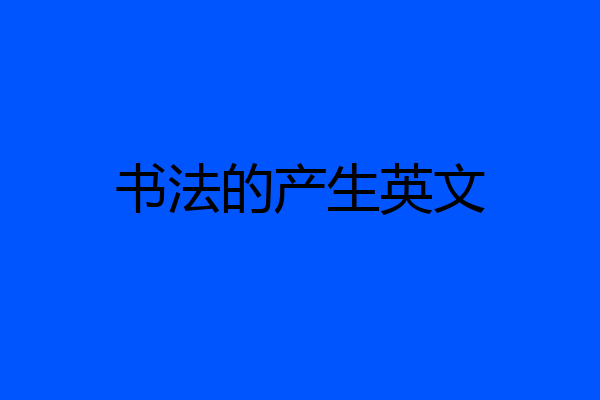
lipingzhou13
“书法”英语单词写法:calligraphy
读法:英 [kə'lɪgrəfɪ] 美 [kə'lɪɡrəfi]
释义:n. 书法;笔迹
例句:
1、His calligraphy is vigorous and forceful.
他的书法苍劲有力。
2、His effortless calligraphy has an unconventional grace of its own.
他的书法, 信笔写来, 十分超脱。
扩展资料
calligraphy的同近义词:writing
读法:英 ['raɪtɪŋ] 美 ['raɪtɪŋ]
释义:
1、n. 书写;作品;著作;[法] 笔迹
2、v. 书写(write的ing形式)
短语:
1、English Writing英语写作
2、Nature Writing自然写作
3、Practical Writing应用文
4、Scientific Writing科技写作
5、News Writing新闻写作


iamYolandaXYZ
The formation and development of Chinese calligraphy is closely related to the generation and evolution of Chinese characters.
中国:China; the People's Republic of China; Sino-; PRC
书法:calligraphy; handwriting; penmanship; hand; pencraft
艺术:art; skill; craft; conforming to good taste
形成和发展:formation and development
汉字:Chinese character; Chinese ideograph; sinogram
产生:produce; engender; emerge; come into being; bring
演变:evolution; evolvement; evolve; develop; outcome
密不可分:interwovenness
关系:relationship; relation; nexus; filiation
扩展资料:
1、中国的文字始于黄河中游的“仰韶文化时期”,书法艺术也从甲骨文开始。历经2000多年的沿袭和发展,不同时期的书法艺术都表现着不同特定时期的社会经济发展和人们的价值取向。
2、中国的书法艺术兴始于汉字的产生阶段,“声不能传于异地,留于异时,于是乎文字生。文字者,所以为意与声之迹。”因此,产生了文字。 书法艺术的第一批作品不是文字,而是一些刻画符号——象形文字或图画文字。汉字的刻画符号,首先出现在陶器上。最初的刻画符号只表示一个大概的混沌的概念,没有确切的含义。
参考资料:书法艺术——百度百科

一知蓝色
书法的英文:calligraphy
calligraphy 读法 英 [kə'lɪgrəfɪ] 美 [kə'lɪɡrəfi]
作名词的意思是:书法;笔迹
短语:
Chinese Calligraphy 中国书法 ; 书法 ; 中国书法艺术 ; 毛笔书法
Calligraphy Association 书法协会 ; 书写艺术协会 ; 学校书法协会 ; 书法协会成立
Calligraphy education 书法教育 ; 书法 ; 写字教育 ; 书法教学
例句:
1、His calligraphy is vigorous and forceful.
他的书法苍劲有力。
2、His effortless calligraphy has an unconventional grace of its own.
他的书法, 信笔写来, 十分超脱。
calligraphy的近义词:Handwriting
Handwriting 读法 英 ['hændraɪtɪŋ] 美 ['hænd'raɪtɪŋ]
作名词的意思是:笔迹;书法;书写;手稿
作动词的意思是:亲手写(handwrite的ing形式)
短语:
Handwriting Fonts 手写字体
Handwriting function 手写功能
Handwriting Recognize 手写识别
例句:
1、Whose handwriting is this? Can you identify it?
这是谁的笔迹, 你辨认得出来吗?
2、You realize what would happen if I handed in my work in your handwriting?
你知道如果我交的作业是你的笔迹,将会发生什么事情吗?

艾米莉郡主
Introduction to Chinese Calligraphy Chinese calligraphy (Brush calligraphy) is an art unique to Asian cultures. Shu (calligraphy), Hua (painting), Qin (a string musical instrument), and Qi (a strategic boardgame) are the four basic skills and disciplines of the Chinese literati. Regarded as the most abstract and sublime form of art in Chinese culture, "Shu Fa" (calligraphy) is often thought to be most revealing of one's personality. During the imperial era, calligraphy was used as an important criterion for selection of executives to the Imperial court. Unlike other visual art techniques, all calligraphy strokes are permanent and incorrigible, demanding careful planning and confident execution. Such are the skills required for an administrator / executive. While one has to conform to the defined structure of words, the expression can be extremely creative. To exercise humanistic imagination and touch under the faceless laws and regulations is also a virtue well appreciated. By controlling the concentration of ink, the thickness and adsorptivity of the paper, and the flexibility of the brush, the artist is free to produce an infinite variety of styles and forms. In contrast to western calligraphy, diffusing ink blots and dry brush strokes are viewed as a natural impromptu expression rather than a fault. While western calligraphy often pursue font-like uniformity, homogeneity of characters in one size is only a craft. To the artist, calligraphy is a mental exercise that coordinates the mind and the body to choose the best styling in expressing the content of the passage. It is a most relaxing yet highly disciplined exercise indeed for one's physical and spiritual well being. Historically, many calligraphy artists were well-known for their longevity. Brush calligraphy is not only loved and practiced by Chinese. Koreans and Japanese equally adore calligraphy as an important treasure of their heritage. Many Japanese schools still have the tradition of having a student contest of writing big characters during beginning of a new school year. A biannual gathering commemorating the Lanting Xu by Wang Xi Zhi (The most famous Chinese calligrapher in Jin dynasty, ) is said to be held ceremonially in Japan. There is a national award of Wang Xi Zhi prize for the best calligraphy artist. Not too long ago, Korean government officials were required to excel in calligraphy. The office of Okinawa governor still displays a large screen of Chinese calligraphy as a dominating decor. In the West, Picasso and Matisse are two artists who openly declared the influence by Chinese calligraphy on their works.多谢你采纳了我的二个答案。但中国书法这篇不行吗?这是专门介绍中国的书法(毛笔书法)的。再奉上另一篇:Chinese Calligraphy The Chinese Brush Calligraphy is one of the traditional four arts which was once an important critical standard for the Chinese literati in the imperial era and now prevails not only in China but also worldwide as a unique branch of art. Calligraphy is so abstract and sublime that in Chinese culture it is universally regarded to be the most revealing power of a person. While one has conformed to the defined structure of words, the expression can be displayed with great creativity by individuals. To become an artist or expert in calligraphy, one has to practice word by word and stroke by stroke until the spirit of the practice gets into one's mind. Just as Chinese Qi Gong, the Chinese brush calligraphy can temper a person into a state in which one can apply subconsciousness got from the daily practice to control the concentration of ink and the compatibility of font and size of each piece or word. In contrast to the Western calligraphy, diffusing ink blots and dry brush strokes are viewed as a natural and free impromptu expression. All the varieties of the operation depend on the mental exercise that coordinates the mind and the body to perform the proper sense to choose the proper way in expressing the content of the passage. Calligraphy is considered as an active way of keeping one fit and health for the practice is either relaxing or self-entertaining. Historically, many calligraphy artists both in China and Japan were well known for their longevity.